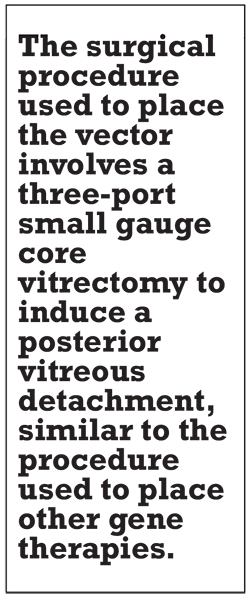RGX-314 is one of a number of gene therapy candidates targeting retinal diseases, but where the bulk of these agents target inherited retinal disease, RGX-314 is unique in that it’s one of the few gene therapies that targets wet age-related macular degeneration. REGENXBIO, the company developing RGX-314, says the goal is to have a one-time subretinal treatment for wet AMD.
RGX-314 includes a vector of adeno-associated virus serotype 8 (AAV8). Because this serotype shows a greater affinity for liver transduction than other serotypes, it is the preferred vector for hemophilia A and familial hypercholesterolemia.1 More recent research in retinal diseases has implicated AAV8 in inducing immune responses in primate retinas2 and, more specifically, in suppressing vascular endothelial growth factor.3
REGENXBIO has developed RGX-314 based on a proprietary platform called NAV. RGX-314 contains a gene that encodes for a monoclonal antibody fragment that binds to and neutralizes VEGF activity.
 |
Phase I/IIa dose-escalation trial
A Phase I/IIa dose-escalation trial is currently evaluating four doses of RGX-314: 3E9 GC/eye; 1E10 GC/eye; 6E10 GC/eye; and 1.6E11 GC/eye. At last report, 30 subjects have been dosed in the trial. The trial is also now recruiting an additional cohort of 12 patients at a dose of 2.5E11 GC/eye.
These trial results will be used to help design the Phase IIb trial, which principal investigator Jeffrey S. Heier, MD, says is scheduled to begin by the end of the year.
Here, Dr. Heier, director of the vitreoretinal service at Ophthalmic Consultants of Boston, answers questions about the Phase I/IIa trial.
Q: What can you tell us about the mechanism of action of RGX-314?
A: RGX-314 utilizes an AAV8 viral vector that carries a gene encoding for an anti-VEGF protein. The vector is taken up preferentially by retinal cells. In essence, it uses the patient’s cells to produce high levels of the therapeutic protein.
Q: How is RGX-314 administered?
A: It’s administered subretinally. The procedure used to place the vector involves a conventional three-port, small- gauge core vitrectomy and, if not already present, a posterior vitreous detachment is induced. Then, using a small-gauge, subretinal cannula, the gene therapy product is introduced into the subretinal space. A bleb is created by injecting 250-μl of the gene therapy product adjacent to, but not in, the macula. This is similar to the procedure used for other retinal gene therapies, such as voretigene neparvovecrzyl (Luxturna, Spark Therapeutics).
Q: What are the potential advantages of subretinal delivery?
A: The hypothesis is that subretinal delivery will provide broader retinal coverage, higher protein expression and reduced sensitivity to neutralizing antibodies than intravitreal delivery. This will potentially lead to higher and longer gene expression.
Q: What have the Phase I/IIa results shown so far?
A: The Phase I/IIa study is designed primarily to evaluate safety, but it is also designed to show long-term protein expression after administering RGX-314. In each cohort we have seen increasing levels of protein expression as measured by anterior chamber taps. Fifty percent of the patients in cohort 3 (6E10 GC/eye) haven’t received any rescue injections out to nine months. Patients in cohort 4 (1.6E11 GC/eye), which is still recruiting, had continued evidence of dose-dependent protein expression.
Q: What are the safety findings at this point?
A: The surgery is well tolerated. Very few complications have been reported. One patient developed a peripheral retinal detachment that was successfully repaired, and that patient continues to do well.
Q: What are the functional and anatomical findings so far?
A: Patients in cohort 3 continued to have stable to increasing visual acuity and stable to decreased retinal thickness despite few injections. Half of these patients (3 of 6) received no further treatment after RGX-314 delivery, and they continued to show stability in terms of retinal thickness.
Q: What types of patients were included in the trial?
A: The patients treated in this study are long-term patients, with an average disease duration of five years and a history of 30-plus injections each. They demonstrated a chronic and frequent need for anti-VEGF injections. The fact that they’ve demonstrated stability in vision up to this point is most encouraging.
Q: Where would RGX-314 fit in real-world practice?
A: The data are overwhelmingly clear that patients in A the real world don’t achieve outcomes that are reported in Phase III randomized clinical trials. We at least hypothesize that that’s largely due to undertreatment. The treatment burden is at least responsible for that. The hope is that we have a treatment that’s far more durable, that will mean patients will need fewer to no injections over a one-to-multi-year span, and that the real-world outcomes will be much closer to those achieved in Phase III studies. RGX-314 would be more for the patients who have demonstrated a very strong dependence on frequent anti-VEGF treatments—that is, monthly or every six or eight weeks.
REFERENCES
1. Nam HJ, Lane MD, Padron et al. Structure of adeno-associated virus serotype 8, a gene therapy vector. J Virol. 2007;81:12260-71
2. Reichel FF, Dauletbekov DL, Klein R, et al., and the RD-CURE Consortium. Mol Ther. 2017;25:2648- 2660. 3.LiuY,FortmannSD,ShenJ,etal.AAV8-antiVEGFfaboculargenetransferforneovascularage-related macular degeneration. Mol Ther. 2018;26:542-549.



